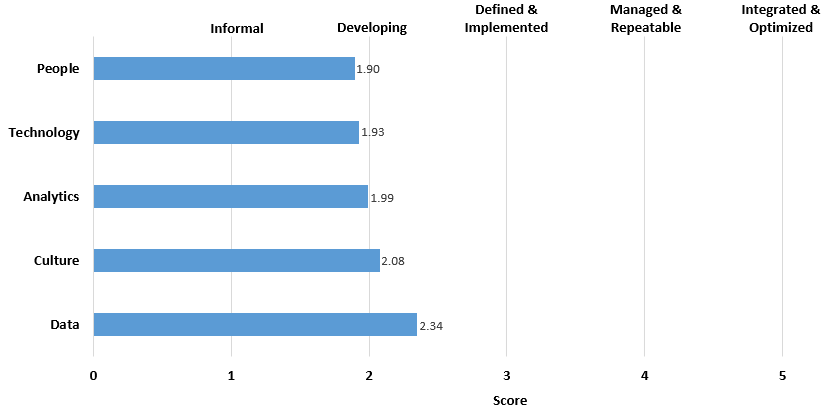Overview
The Federal Data Strategy requires that agencies conduct data management maturity assessments. These assessments are useful in evaluating existing data management processes and capabilities, identifying how they meet mission needs, and suggesting opportunities for improvement. During FY2020, DOL developed a maturity assessment tool based off of the Advanced Analytics Capability Maturity Model (A2CM2).
Significant Components of Data Management Maturity
DOL assessed maturity in five core areas of data management including: data, analytics, technology, people, and culture.
How Do We Measure Maturity?
The maturity scale in the models we use ranges from 1 (lowest level of capability) to 5 (highest level of capability).
- The lowest category (level 1) reflects capabilities we do not have, or processes that are locally managed, and operating in an ad hoc manner based on whatever existing resources and tools are available without respect to what anyone else in the enterprise does.
- The highest category (level 5) indicates a capability or process that is well understood with respect to process and perceived value, staff are trained and knowledgeable in its use, and the process is sophisticated, automated, standardized, and optimized across the whole enterprise.
- Categories 2 through 4 identify intermediate steps between lowest to highest, and form a continuum or gradient reflecting incremental progress toward higher levels of capability.
Maturity Assessment Results
The results of DOL’s assessment using this model ranked overall capabilities as developing with an average score of 2; the lowest scores being in people and technology (1.9) and the highest scores being in data (2.3).
| Element | Score |
| People | 1.90 |
| Technology | 1.93 |
| Analytics | 1.99 |
| Culture | 2.08 |
| Data | 2.34 |
Key Findings
Areas identified as relatively lower in maturity and targeted for improvement and more optimal data management, process, and use include:
- Data - data documentation (1.9) and metadata management (2.0)
- Analytics – selection criteria for analytics projects (1.6) and management of analytical projects in a way maximizes impact on organizational needs (1.6)
- Technology – internal lifecycle development process to support analytical tools (1.5)
- People – profiling and sourcing data talent (1.5)
- Culture – leadership engagement and value of data as a strategic asset to support evidence based decision making (1.5)
Assessment reveals that for DOL to progress in maturity, it is critically important to invest in foundational capabilities such as building data talent, standardizing data management across the enterprise, improving documentation, establishing an effective metadata framework, and standardizing technological lifecycle processes specific to the development of advanced analytical tools.
Many of the areas for improvement are centered around supporting organizational cultural change, from basic data collection and management up through program leadership, to value data as a strategic asset, ensuring all data are fit for purpose and can be used throughout the enterprise in predictable and consistent ways. The Office of Data Governance is supporting this work through a number of channels of activity including but not limited to:
- Establishing Data Governance Roles like agency Chief Data Stewards who effectively collaborate on DOL Data Board projects and engage with their agency leadership to bring about the kind of culture change needed to advance data as a strategic asset.
- Developing an Enterprise Data Inventory to understand the breadth of data assets that need to be described and managed.
- Founding a Metadata Schema for describing DOL datasets in a consistent and predictable way to ensure that data are interoperable across the enterprise.
- Creating a controlled vocabulary containing Tags and keyword for categorizing datasets to ensure data are easily findable within DOL.
- Incorporating a data theme into Agency Management Plans with guidance on data projects (e.g. data governance, talent, use, and access) that align work with agency and departmental priorities to return the greatest value to DOL and its stakeholders.
- Forming Data Board Working Groups around data talent, equity, data-informed enforcement, and analytics.
- Collaborating with Office of the Chief Information Officer (OCIO) partners on the development lifecycle of transformational technological capabilities that support open data, data sharing, and advanced analytical capabilities.
Evolving Work
Data Governance is more of a process than a project, and as such, it is constantly evolving in response to changing requirements, emerging technology and risks, and evolving capabilities and awareness of how data can best be leveraged to bring value to the enterprise. DOL’s strategic planning and proposed activities to support higher levels of data management maturity over the next three years can be found in the DOL Data Strategy.

